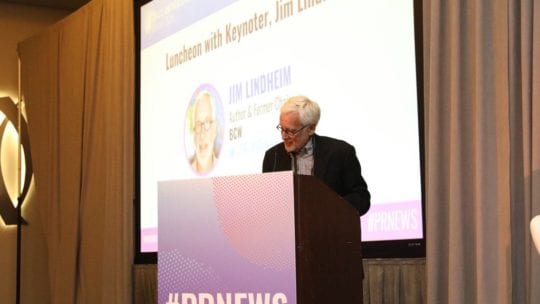
Many of the principles of crisis management are similar to those Jim Lindheim learned 30 years ago, the former Burson-Marsteller chairman and novelist told PRNEWS' Crisis & Measurement Summit in Miami Tuesday (Feb. 25, 2020).
“That’s good news. They're being passed down," he said during his luncheon keynote. The question, though, is why, if crisis management rules are well known, iconic companies and organizations experience PR crises regularly? He cited Wells Fargo, Boeing, the Houston Astros and Major League Baseball and Facebook as examples. All those entities have crisis plans, Lindheim said, but they failed to use them when they needed to most.
He likened the situation to something boxer Mike Tyson said: “Everyone has a plan until they get punched in the mouth.”
For Lindheim, a veteran of PR crises, including New Coke and Tylenol, several elements overtake crisis plans. Corporate culture, for example, is a critical element, though it's often overlooked. For instance, C-suite members often are not aligned on crisis response, Lindheim said. Are C-suite members who might have inadvertently caused a crisis, likely to embrace the principle of owning your mistake?
In addition, corporate power structures play a major role. "There's nothing more autocratic than a corporation," Lindheim said. Suppose a CEO refuses to address a PR crisis, or worse, enflames the situation with a rant on social media? For Lindheim, these are some of the reasons you see iconic companies flounder, despite having great crisis plans.
On the upside, communicators can use data and measurement to manage crises. He urged PR pros to make arguments about shaping crisis response using data obtained via social listening.
Takeaways
After a day of sessions that included "Media Training Must-Haves," "Creating a Water-Tight Social Crisis Plan" and a "Real-Time Crisis Simulation," attendees heard about these key takeaways, including:
- Have a preparedness plan, but be sure it’s updated regularly. In addition, create a crisis task force to make decisions quickly. Also, remember to broaden your thinking about crisis by considering business continuity and internal communications to employees.
- Ensure you have the right people for crisis response. This should not necessarily include the C-suite, as this could potentially escalate the crisis. Identify the best experts to address particular situations.
- Integrate content strategy guidelines into your crisis plan, including a social media response. A content strategy should include pre-approved statements that you can tailor quickly. You might mean coming at misinformation with a sledgehammer; however, ensure you do not come at partial misinformation with a sledgehammer.
- Use your personality. Who your brand is should not change. Be authentic and transparent and as true to your brand’s values as possible. Also ensure that your social media team has a seat at the table, and have a social media kill switch.
- Scenario planning is critical; evolve strategy for new elements: technology, staff, regulatory issues and business environments. Consider your location and audience. For example, if you’re based in Florida, don’t wait until hurricane season to refresh your crisis planning.
- While media training is critical, a crisis is not the time to do it. When a crisis hits, it’s about the refresher and what you will say to satisfy your stakeholders. Ensure you use language that the general public will understand; when the public is confused, a crisis escalates.
